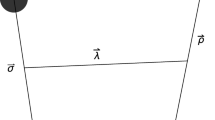Abstract
The 2020 announcement by LHCb of a narrow structure \(X(6900)\) in the di-\(J/\psi\) spectrum—a potential \(c\bar{c}c\bar{c}\) state—has opened a new era in hadronic spectroscopy. In this talk, we briefly survey theory works preceding this event, examine key features of the observed spectrum, and then discuss how subsequent theory studies (including with the author’s own dynamical diquark model) have interpreted these features. We conclude with proposals for experiments capable of distinguishing competing interpretations.

Similar content being viewed by others
REFERENCES
R. Aaij et al. (LHCb Collab.), ‘‘Observation of structure in the \(J/\psi\)-pair mass spectrum,’’ Sci. Bull. 65, 1983 (2020); arXiv: 2006.16957 [hep-ex].
S. Durgut (CMS Collab.). http://meetings.aps.org/Meeting/APR18/Session /U09.6.
L. Bland et al. (ANDY Collab.), ‘‘Observation of Feynman scaling violations and evidence for a new resonance at RHIC,’’ arXiv: 1909.03124 [nucl-ex] (2019).
R. Aaij et al. (LHCb Collab.), ‘‘Search for beautiful tetraquarks in the \(\Upsilon(1S)\mu^{+}\mu^{-}\) invariant-mass spectrum,’’ J. High Energy Phys. 2018, 086 (2018); arXiv: 1806.09707 [hep-ex].
A. Sirunyan et al. (CMS Collab.), ‘‘Measurement of the \(\Upsilon\)(1S) pair production cross section and search for resonances decaying to \(\Upsilon\)(1S)\(\mu^{+}\mu^{-}\) in proton-proton collisions at \(\sqrt{s}=\) 13 TeV,’’ Phys. Lett. B 808, 135578 (2020); arXiv: 2002.06393 [hep-ex].
R. Maciuła, W. Schäfer, and A. Szczurek, ‘‘On the mechanism of \(T_{4c}\)(6900) tetraquark production’’ Phys. Lett. B 812, 136010 (2021); arXiv: 2009.02100 [hep-ph].
J. Zhao, S. Shi, and P. Zhuang, ‘‘Fully-heavy tetraquarks in a strongly interacting medium,’’ Phys. Rev. D 102, 114001 (2020); arXiv: 2009.10319 [hep-ph].
A. Esposito, C. Manzari, A. Pilloni, and A. Polosa, ‘‘Hunting for tetraquarks in ultra-pheripheral heavy ion collisions,’’ Phys. Rev. D 104, 114029 (2021); arXiv: 2109.10359 [hep-ph].
R. Lebed, R. Mitchell, and E. Swanson, ‘‘Heavy-quark QCD exotica,’’ Prog. Part. Nucl. Phys. 93, 143 (2017); arXiv: 1610.04528 [hep-ph].
P. Zyla et al. (Particle Data Group), ‘‘Review of particle physics,’’ Prog. Theor. Exp. Phys. 2020, 083C01 (2020).
C. Gong, M.-C. Du, Q. Zhao, X.-H. Zhong, and B. Zhou, ‘‘Nature of \(X(6900)\) and its production mechanism at LHCb,’’ Phys. Lett. B 824, 136794 (2022); arXiv: 2011.11374 [hep-ph].
X.-K. Dong, V. Baru, F.-K. Guo, C. Hanhart, A. Ne- fediev, and B.-S. Zou, ‘‘Is the existence of a \(J/\psi J/\psi\) bound state plausible?,’’ Sci. Bull. 66, 1577 (2021); arXiv: 2107.03946 [hep-ph].
Y. Iwasaki, ‘‘A possible model for new resonances-exotics and hidden charm,’’ Prog. Theor. Phys. 54, 492 (1975).
J. Aubert et al. (E598 Collab.), ‘‘Experimental observation of a heavy particle \(J\),’’ Phys. Rev. Lett. 33, 1404 (1974).
J. Augustin et al. (SLAC-SP-017), ‘‘Discovery of a narrow resonance in \(e^{+}e^{-}\) annihilation,’’ Phys. Rev. Lett. 33, 1406 (1974).
A. Berezhnoy, A. Likhoded, A. Luchinsky, and A. Novoselov, ‘‘Double \(J/\psi\)-meson production at LHC and 4\(c\)-tetraquark state,’’ Phys. Rev. D 84, 094023 (2011); arXiv: 1101.5881 [hep-ph].
A. Berezhnoy, A. Luchinsky, and A. Novoselov, ‘‘Tetraquarks composed of 4 heavy quarks,’’ Phys. Rev. D 86, 034004 (2012); arXiv: 1111.1867 [hep-ph].
L. An (LHCb Collab.), ‘‘Latest results on exotic hadrons at LHCb,’’ (2020). https://indico.cern.ch/event/900972/
J.-W. Zhu, X.-D. Guo, R.-Y. Zhang, W.-G. Ma, and X.-Q. Li, ‘‘A possible interpretation for \(X(6900)\) observed in four-muon final state by LHCb: A light Higgs-like boson?,’’ arXiv: 2011.07799 [hep-ph] (2020).
X.-K. Dong, V. Baru, F.-K. Guo, C. Hanhart, and A. Nefediev, ‘‘Coupled-channel interpretation of the LHCb double-\(J/\psi\) spectrum and hints of a new state near the \(J/\psi J/\psi\) threshold,’’ Phys. Rev. Lett. 126, 132001 (2021).
X.-K. Dong, V. Baru, F.-K. Guo, C. Hanhart, and A. Nefediev, Phys. Rev. Lett. 127, 119901(E) (2021); arXiv: 2009.07795 [hep-ph].
Z.-H. Guo and J. Oller, ‘‘Insights into the inner structures of the fully charmed tetraquark state \(X(6900)\),’’ Phys. Rev. D 103, 034024 (2021); arXiv: 2011.00978 [hep-ph].
J.-Z. Wang, D.-Y. Chen, X. Liu, and T. Matsuki, ‘‘Producing fully charm structures in the \(J/\psi\)-pair invariant mass spectrum,’’ Phys. Rev. D 103, 071503 (2021); arXiv: 2008.07430 [hep-ph].
J. Sonnenschein and D. Weissman, ‘‘Deciphering the recently discovered tetraquark candidates around 6.9 GeV,’’ Eur. Phys. J. C 81, 25 (2021); arXiv: 2008.01095 [hep-ph].
J. Giron and R. Lebed, ‘‘Simple spectrum of \(c\bar{c}c\bar{c}\) states in the dynamical diquark model,’’ Phys. Rev. D 102, 074003 (2020); arXiv: 2008.01631 [hep-ph].
M. Karliner and J. Rosner, ‘‘Interpretation of structure in the Di-\(J/\psi\) spectrum,’’ Phys. Rev. D 102, 114039 (2020); arXiv: 2009.04429 [hep-ph].
B.-C. Yang, L. Tang, and C.-F. Qiao, ‘‘Scalar fully-heavy tetraquark states \(QQ^{\prime}{\bar{Q}}\bar{Q^{\prime}}\) in QCD sum rules,’’ Eur. Phys. J. C 81, 324 (2021); arXiv: 2012.04463 [hep-ph].
Z. Zhao, K. Xu, A. Kaewsnod, X. Liu, A. Limphirat, and Y. Yan, ‘‘Study of charmonium like and fully-charm tetraquark spectroscopy,’’ Phys. Rev. D 103, 116027 (2021); arXiv: 2012.15554 [hep-ph].
C. Deng, H. Chen, and J. Ping, ‘‘Towards the understanding of fully-heavy tetraquark states from various models,’’ Phys. Rev. D 103, 014001 (2021); arXiv: 2003.05154 [hep-ph].
M. Bedolla, J. Ferretti, C. Roberts, and E. Santopinto, ‘‘Spectrum of fully-heavy tetraquarks from a diquark+antidiquark perspective,’’ Eur. Phys. J. C 80, 1004 (2020); arXiv: 1911.00960 [hep-ph].
R. Lebed, ‘‘Spectroscopy of exotic hadrons formed from dynamical diquarks,’’ Phys. Rev. D 96, 116003 (2017); arXiv: 1709.06097 [hep-ph].
J.-M. Richard, ‘‘About the \(J/\psi\) \(J/\psi\) peak of LHCb: Fully-charmed tetraquark?,’’ Sci. Bull. 65, 1954 (2020); arXiv: 2008.01962 [hep-ph].
Q.-F. Cao, H. Chen, H.-R. Qi, and H.-Q. Zheng, ‘‘Some remarks on \(X(6900)\),’’ Chin. Phys. C 45, 103102 (2021); arXiv: 2011.04347 [hep-ph].
Funding
This work was supported by the US National Science Foundation (NSF), grant nos. PHY- 18030912 and PHY-2110278.
Author information
Authors and Affiliations
Corresponding author
Ethics declarations
The author declares that he has no conflicts of interest.
About this article
Cite this article
Lebed, R.F. All Heavy Tetraquarks:The Dynamical Diquark Model and Other Approaches. Moscow Univ. Phys. 77, 458–461 (2022). https://doi.org/10.3103/S002713492202059X
Received:
Published:
Issue Date:
DOI: https://doi.org/10.3103/S002713492202059X




